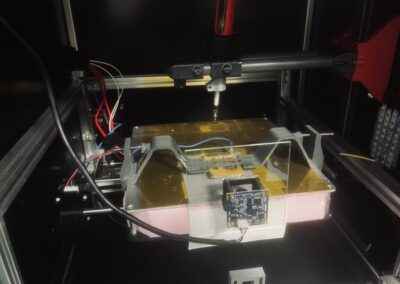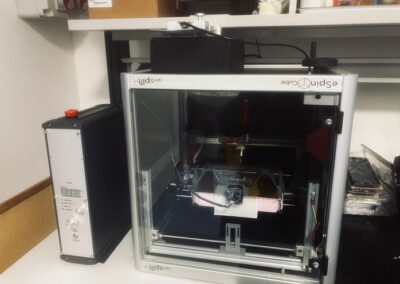Pilot Experiments
SprayCube: manufacturing framework for new generation solar panels
Hungary, Budapest
![]() BME-EET-DIH
BME-EET-DIH
Experiment objective
The general objective of the SprayCube experiment is to integrate a smart modelling technology with the support of BME-EET-DIH, into an electrosprayer machine, a product of a manufacturing SME Spinsplit, operating in the Electrical and optical equipment sector. The new product, a digital manufacturing framework, will enable faster development and manufacturing of new generation Perovskite solar cell modules, using Digital Twin approach. To achieve the general objective, the following SMART objectives were identified:
- Adaptation of a Digital Twin model of photovoltaic devices that is designed to predict the behaviour and process parameters of to-be-created Perovskite based solar cells;
- The development of an electrosprayer machine to ensure reliable and homogeneous material layer deposition needed for creating the Perovskite solar cell structures;
- Design a manufacturing framework that integrates i) the electrosprayer machine to create adequate solar cell structures and ii) the Digital Twin to control the process parameters.
The results of the experiment will boost the digitalization level of the SME, Spinsplit’s manufacturing processes and generates a new, innovative product which builds competitive advantage for the SME, through utilizing the digital technologies provided by BME-EET-DIH.
Challenges
The formation of the crystalline Perovskite layer as a key technology step of creating solar cells, have been implemented by various techniques from inkjet printing to vapour deposition.
One of such promising technologies is the physical vapour deposition of the perovskite layer using electrospraying, which is especially suitable for industrial scale production. Electrosprayers use high voltage electric field to vaporize and deposit compounds (e.g. Perovskite) from their liquid solutions.
Highly effective solar cells are designed to meet technical (e.g. expected lifespan), environmental (temperature, numbers of hours of sunshine etc.) and user (e.g. power capacity) requirements. It is also expected that to exploit the solar irradiation as much as possible there will be a paradigm shift towards solar cells that are adapted and optimized to specific characteristic operational conditions (warm climate, long overcast periods, semi-transparent solar cells for windows, split spectrum applications, etc.) instead of using the same device architecture for all purposes. The necessary key characteristics are greatly influenced by the technology parameters used for the manufacturing of the cell. Digital Twins are computational models which can predict the real behaviour of manufactured solar cells under real-life operational conditions, based on a-priori characterisation/simulation data and specifications. The proposed activity is aiming to optimize the technology parameters of electrospraying-based Perovskite layer formation, provided by the Digital Twin model which calculates them based on the specification requirements.
The solar-cell model (Digital Twin) developed and maintained by BME-EET-DIH is a semi empirical, combined electro-thermal-radiometric multiphysics model based on the single diode approach and incorporation a static thermal model for the module. The Digital Twins based on BME’s modelling approach use temperature, wind speed and direction, device orientation and irradiation intensity and spectrum as input parameters to give a behavioural description of the modelled device. By translating the specifications or characteristic operational conditions to these parameters, optimized cells design (bandgap, layer thickness, cell size, etc.) can be extracted. These parameters can be translated to the process parameters of the perovskite layer deposition system.
Implementation Solution
The novel combination of such Digital Twin model and electrospraying technology is beyond the state-of-the-art and will result in a first-of-its-kind manufacturing framework for Perovskite layer formation. Such technology was validated in the framework of a previous cooperation of the SME and the DIH (TRL-4). In the frame of this experiment, we are aiming to validate the technology in relevant environment (TRL-5).
The technical implementation of the SprayCube concept relies on the existing components owned and developed by the DIH and by the SME. Spinsplit IoT is the core component of the commercially available electrospinner/electrosprayer system offered by Spinsplit. A number of hardware changes however needed to optimise the machine for Perovskite layer deposition including mechanical re-design and the incorporation of a XY-stage controller, which provides the movement of the target collector to ensure homogeneous distribution of Perovskite layer. The Quality Assurance (QA) system (process camera, environmental sensors) also must be adapted to the requirements of Perovskite layer deposition. One of the core tasks of the experiment is the integration of the electrosprayer machine and the Digital Twin. Spinsplit IoT is controlled by the user software Spinstudio. This software is already capable of controlling Spinsplit nanotechnology instruments; however, an application programming interface (API) should be developed to ensure the compatibility with the Digital Twin’s output. In the envisioned manufacturing framework, the PSC specification is provided, and the Digital Twin model adds the necessary process parameters for Spinstudio, which controls the electrosprayer hardware as specified through Spinsplit IoT.
Results Obtained
The main results of the experiment are:
- The development of the PSC Digital Twin, which is based on a Single Diode Model, representing an optimal compromise between accurate operational description and simple handling.
- Definition of the system level specifications both for the Digital Twin and for the electrosprayer unit.
- Hardware and software development of the manufacturing framework.
Validation of the implemented hardware and software components.
Impact of the experiment
There is no such system available in the market with built-in digital twin model which may reduce the design time. In this sense, the main impact of the project will be economical impact as fostering the exploitation of novel solar cell technologies.



